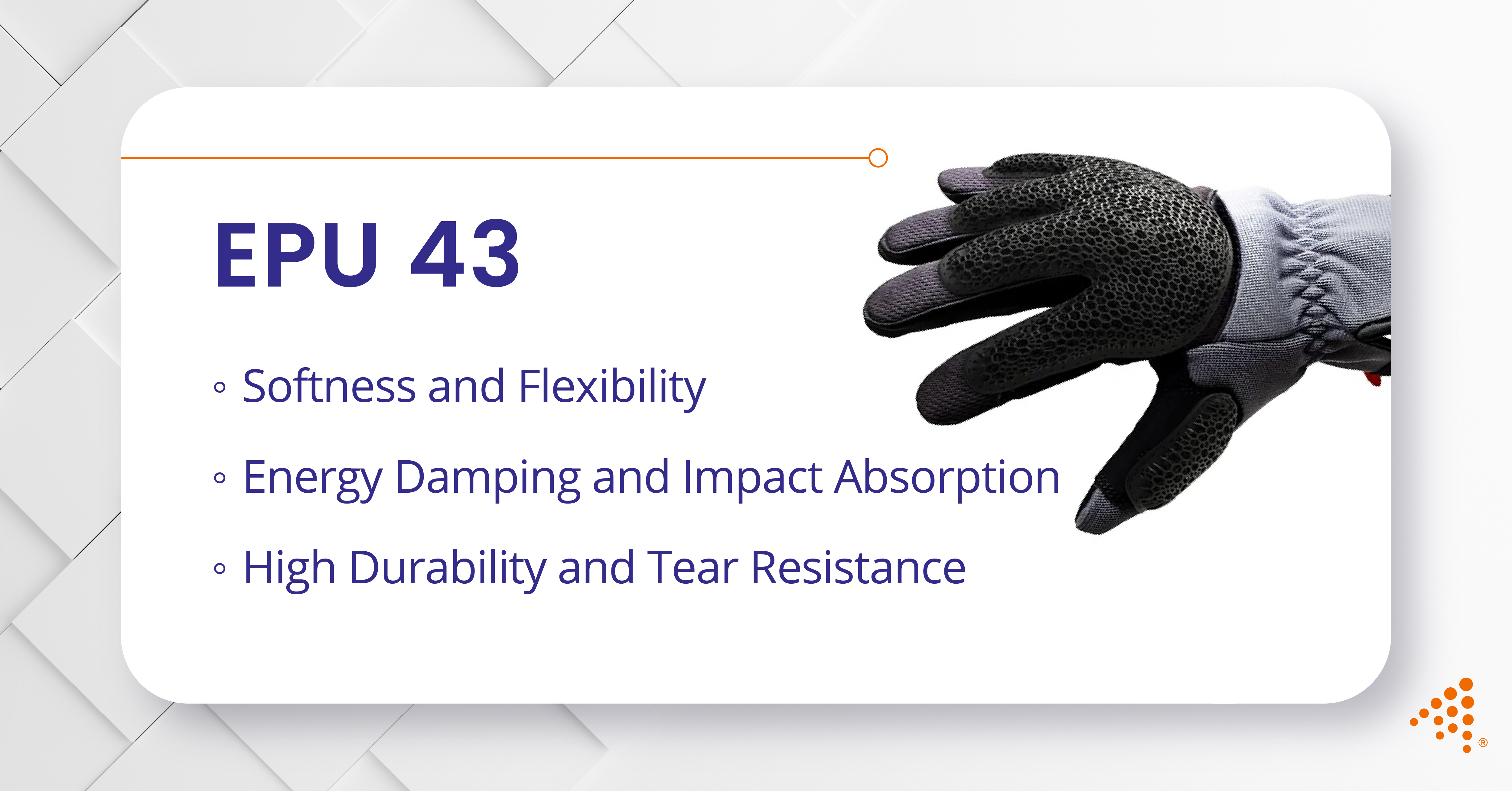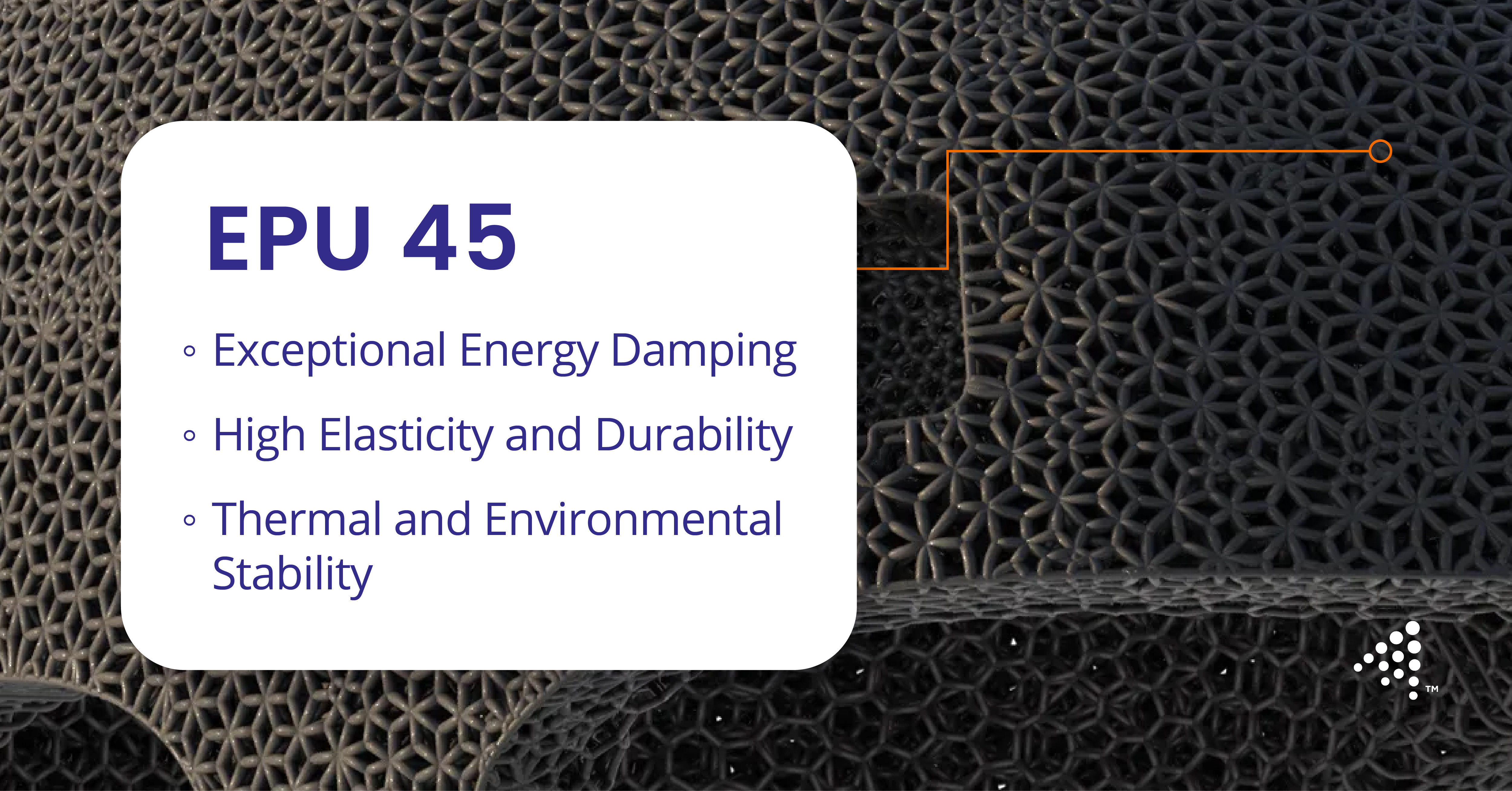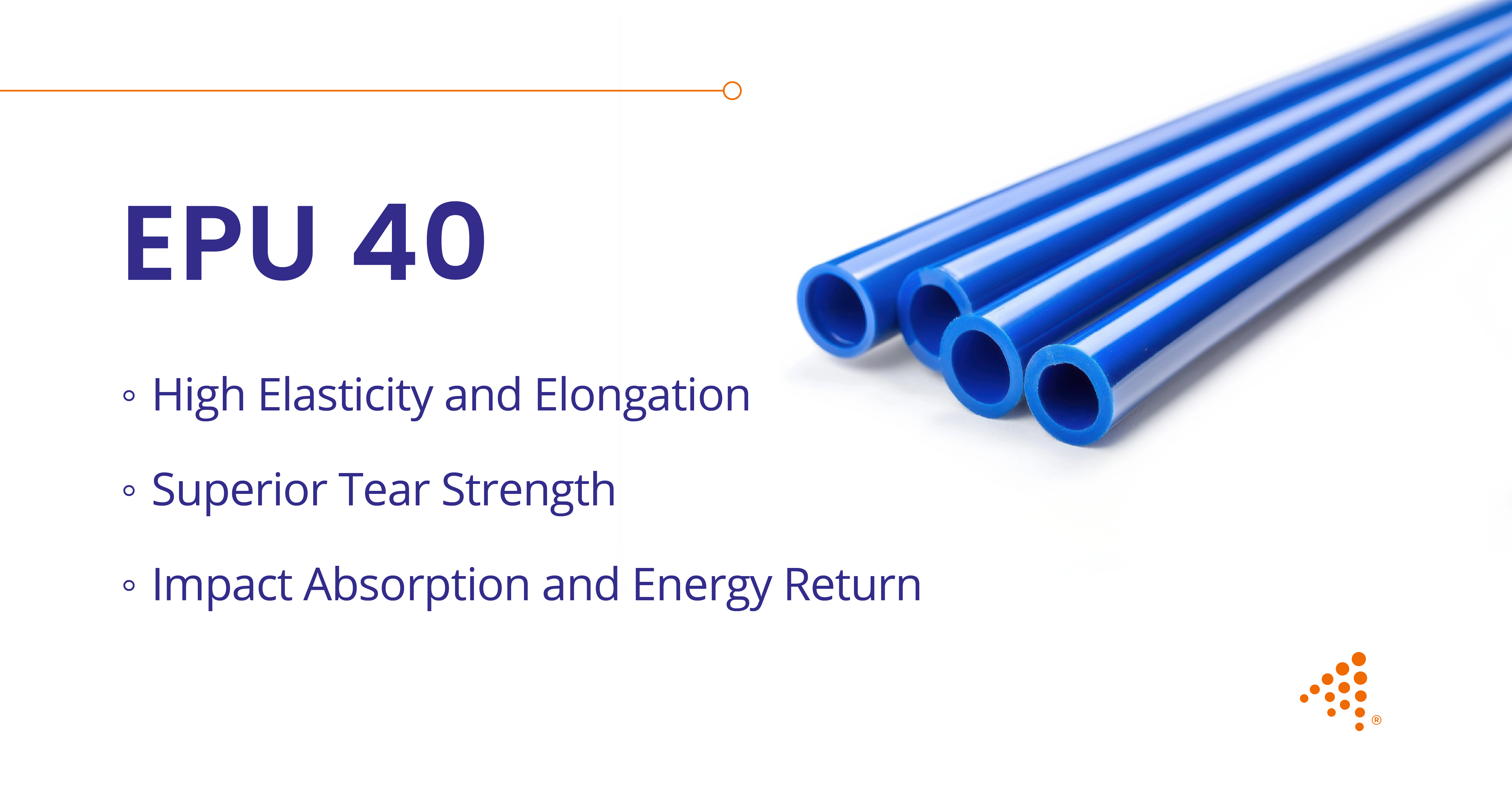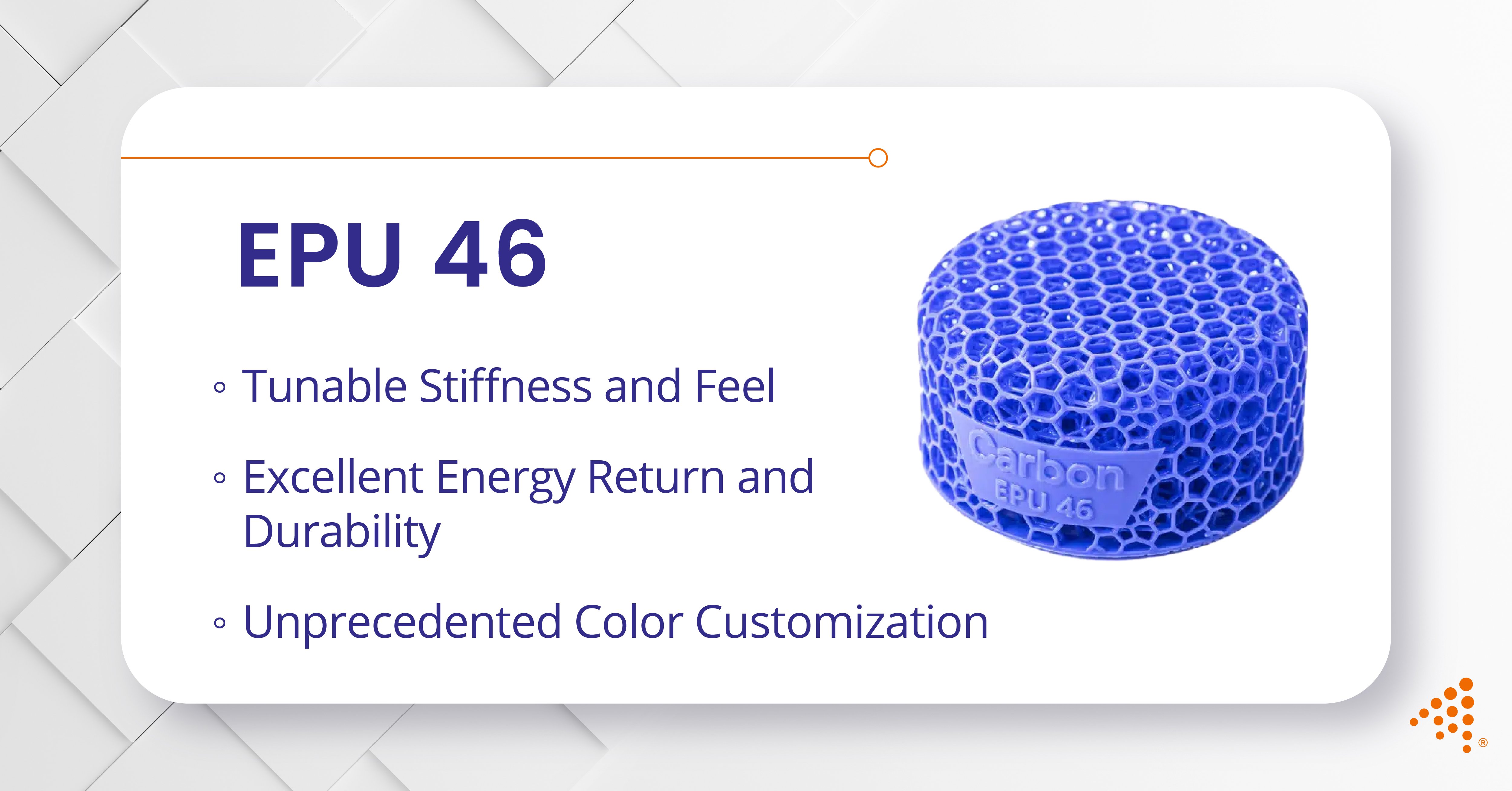EPU 45: The Ultimate Energy-Damping Elastomer for Advanced Manufacturing
Elastomeric Polyurethane (EPU) 45 is a high-performance photopolymer resin engineered for the Carbon Digital Light Synthesis™ (DLS™) process. This...

Elastomeric Polyurethane (EPU) 43 is a high-performance, energy-damping elastomer developed by Carbon for its Digital Light Synthesis™ (DLS™) additive manufacturing technology. This soft, yet durable material is engineered to offer exceptional performance in applications that demand high elasticity, impact resistance, and long-term durability under cyclic flexing. Its unique properties make it an ideal candidate for producing complex, lattice-structured components that were previously impossible to manufacture with traditional methods like injection molding or through conventional plastic injection molding services.
EPU 43 is distinguished by a unique combination of properties that make it suitable for a wide range of demanding product environments.
With a Shore A hardness of 76, EPU 43 is a soft elastomer that provides a high degree of flexibility. This softness, combined with its ability to be printed in intricate lattice geometries, allows for the creation of parts that offer superior comfort and conformity to the human body. This characteristic is particularly valuable in the design of ergonomic and wearable products, especially when paired with design for manufacturing services aimed at optimizing comfort and performance.
One of the most notable features of EPU 43 is its excellent energy-damping capability. It is designed to absorb and dissipate impact forces effectively, protecting the user from shocks and vibrations. This makes it a prime material for protective gear and cushioning components where mitigating impact is a critical function. The material's performance in this area opens up new possibilities for creating safer and more comfortable products using advanced additive manufacturing solutions.
Despite its softness, EPU 43 exhibits remarkable durability and tear strength. It can withstand over 350,000 cycles in Ross Flexing Fatigue tests without degradation, even in varied temperature and humidity conditions. This long-term resilience means that components made from EPU 43 will maintain their integrity and performance over extended periods of use, a crucial factor for many consumer and industrial products, including low-volume injection molding alternatives where longevity is key.
EPU 43 has passed ISO 10993-5 and -10 standards for cytotoxicity and skin irritation and sensitization, respectively. This biocompatibility makes it a safe material for skin-contact applications, expanding its use into the medical and consumer wellness sectors. This is a significant advantage for products that are worn for extended periods, especially in the production of medical device prototypes and other FDA-compliant manufacturing solutions.
Need Help with Material Selection or DFM Services?
Our team specializes in design for manufacturing solutions, additive manufacturing services, and plastic injection mold design services.
The unique properties of EPU 43 lend themselves to a variety of innovative applications across multiple industries.
The exceptional energy absorption of EPU 43 makes it a premier choice for protective gear. It is used in applications such as helmet liners, padding for safety gloves, and other protective equipment where impact mitigation is paramount. The ability to create complex lattice structures allows for optimized airflow and reduced weight, enhancing user comfort without compromising safety. For clients seeking design for manufacturing solutions focused on impact-resistant products, EPU 43 provides excellent performance.
Given its biocompatibility and softness, EPU 43 is well-suited for medical devices and wearables that come into direct contact with the skin. This includes items like prosthetic liners, custom orthotic components, and cushioning for patient support surfaces. Its flexibility and durability contribute to the creation of more comfortable and effective medical products.
In the realm of consumer goods, EPU 43 is utilized in products that benefit from its cushioning and durability. Examples include high-performance athletic footwear, comfortable and resilient backpack straps, and ergonomic grips for tools and sporting equipment. The material’s ability to be precisely tuned for performance characteristics allows for a high degree of customization in these applications. Leveraging additive manufacturing services, manufacturers can prototype and produce consumer goods faster and more efficiently.
Read More About PMMA (Acrylic): Resin for Clear and Durable Applications
EPU 43 is often compared to Thermoplastic Polyurethane (TPU) elastomers, a common material in the world of injection molding. While both are polyurethanes and share some characteristics, there are key differences that set them apart. TPUs are known for their broad range of durometers, good tear strength, and chemical resistance. EPU 43, with a Shore A hardness of 76, falls within the softer range of TPUs and exhibits similar elasticity and abrasion resistance.
The primary advantage of EPU 43, however, lies in its superior energy damping and its suitability for the DLS™ additive manufacturing process. This allows for the creation of complex geometries and lattice structures that are not achievable through traditional injection molding. These intricate designs can be engineered to provide tunable stiffness and unparalleled comfort and impact absorption. While injection molding with TPU is a highly efficient process for high-volume production of simpler parts, the design freedom offered by EPU 43 and the Carbon DLS™ technology enables the development of next-generation products with enhanced performance characteristics that are simply not possible with conventional manufacturing techniques. This is where design and manufacturing companies are increasingly turning to Carbon DLS prototyping and additive manufacturing tooling solutions for production flexibility.
Read More About RPU 130: High-Performance, Heat-Resistant Resin
While EPU 43 offers many advantages, there are some considerations to keep in mind when selecting it for a project.
EPU 43 has a glass transition temperature of approximately 23°F (-5°C). This means its mechanical properties can change at lower temperatures, and it may not be suitable for applications that require consistent performance in extreme cold. Its operational temperature range is generally more limited compared to some high-performance thermoplastics used in injection molding.
While it offers good resistance to many common chemicals, EPU 43 may not be the best choice for applications involving prolonged exposure to certain aggressive solvents or oils. It is always recommended to test the material's compatibility with any specific chemicals it may encounter in its intended environment.
Parts printed with EPU 43, like other materials used in the Carbon DLS™ process, require post-processing steps including washing and curing. While these steps are integral to achieving the final material properties, they do add to the overall manufacturing time and complexity.
Get Faster Prototypes with Carbon DLS Prototyping
Leverage our Carbon DLS prototyping expertise for 3D printed prototypes and medical device prototypes with fast turnaround and production-quality results. Perfect for teams needing quick iterations before full-scale production.
EPU 43 is an ideal material choice when the primary design considerations are superior energy absorption, long-term durability, and the creation of complex, lightweight structures. Its unique combination of softness, flexibility, and impact resistance allows for the design and production of parts that can significantly enhance user comfort and safety. For companies looking to push the boundaries of product performance, especially in the medical, protective equipment, and high-performance consumer goods sectors, EPU 43 offers a powerful tool for innovation. The ability to move from idea to production with a material that rivals the performance of traditional elastomers, while offering unparalleled design freedom, makes EPU 43 a compelling choice for forward-thinking product development and manufacturing. It’s also an excellent option for organizations seeking to complement their injection mold design services with additive manufacturing capabilities.
Read More About Key Factors for Selecting the Best Injection Molding Tooling Supplier
At Aprios, we can help you choose the right material for your specific needs. Get in touch for expert advice and solutions tailored to your project!
You can also view our Material Selection tool.

Elastomeric Polyurethane (EPU) 45 is a high-performance photopolymer resin engineered for the Carbon Digital Light Synthesis™ (DLS™) process. This...

Elastomeric Polyurethane (EPU 40) is a high-performance additive manufacturing material developed by Carbon, renowned for its unique combination of...

Elastomeric Polyurethane (EPU) 46 is a versatile, high-performance elastomer from Carbon that stands out for its unique combination of durability,...